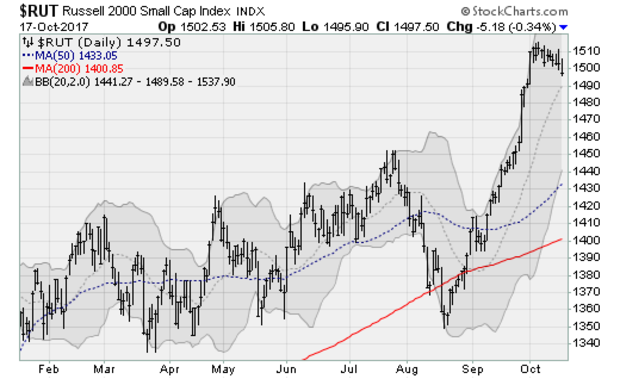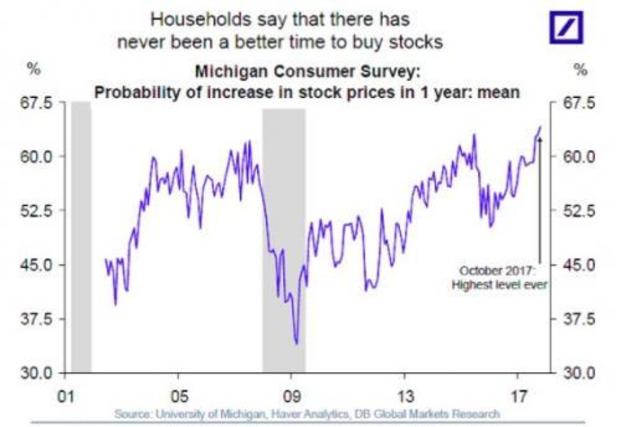Dow 23,000: The latest push hides lingering risks
The Dow Jones Industrials index crossed over the 23,000 level again on Wednesday to close at a record 23,157. No single catalyst accounts for the Dow's rise -- it's merely a continuation of the massive upward momentum in U.S. equities that has dominated Wall Street since the August lows.
Investors are largely ignoring the third-quarter earnings season. The specter of a Federal Reserve rate hike in December doesn't seem to matter. And the somewhat dimmed hopes for President Donald Trump's tax cuts are replaced by a focus on a new bipartisan compromise on health care.
Characterizing this market's persistent rise has been a historic lack of volatility. Jason Goepfert at SentimenTrader noted that over the past month, not one day has registered a "-1,000 tick" reading on the New York Stock Exchange. That means there hasn't been a single day where more than 1,000 stocks trade on a down tick than an uptick. That's a record for this bull market.
Volume has been comatose: The S&P 500 SPDRs (SPY) exchange-traded fund hit a new 52-week high -- on a 52-week low in volume. The only other nonholiday on which that happened in the past 24 years was on Aug. 7 this year, just before a "huge" 2.4 percent pullback.
The latest upswing's breadth is also weak, with just six Dow components responsible for more than half of the rise. And intraday price ranges have been near record lows.
Bank of America Merrill Lynch noted that the S&P 500 has traded 1 percent or more in either direction eight times so far this year; tied with 1965 (full year) for the third lowest in history. The only years with quieter conditions were 1964 and 1963.
Compare that to the situation in 2008, which had 134 days with a 1 percent or greater move. All of this is made more impressive by the seasonal headwinds stocks traditionally face in September and October, with November through January historically a strong stretch -- "Santa Rally" and all that.
It's worth noting that in the early 1960s, like now, the Federal Reserve was keeping monetary policy relatively easy despite a very tight labor market as measures of inflation were tepid. That proved an epic policy mistake: Inflation materialized shortly thereafter, but the Fed wasn't willing politically to hike rates hard enough in response. That led to two decades of higher interest rates and stagnant stock prices.
Keep an eye on small-cap stocks (chart above), which are dribbling lower in stark contrast to the action in large-cap issues. That could be a sign that a bout of profit-taking, long overdue, is coming. The last major pullback for the S&P 500 was in February 2016, when energy prices bottomed.
But based on the way retail investors are piling in, any pullback could merely be a prelude to even higher prices. In its second-quarter earnings call, executives at Charles Schwab (SCHW) announced that it's adding new accounts at levels not seen since the dot-com bubble of the late 1990s, up 34 percent over last year. Cash levels have fallen to a point reached only one other time since the financial crisis.
Folks are all in. This is backed up by the recent University of Michigan Consumer Survey (chart below), which shows that American households feel there has literally never been a better time to buy stocks than right now.






